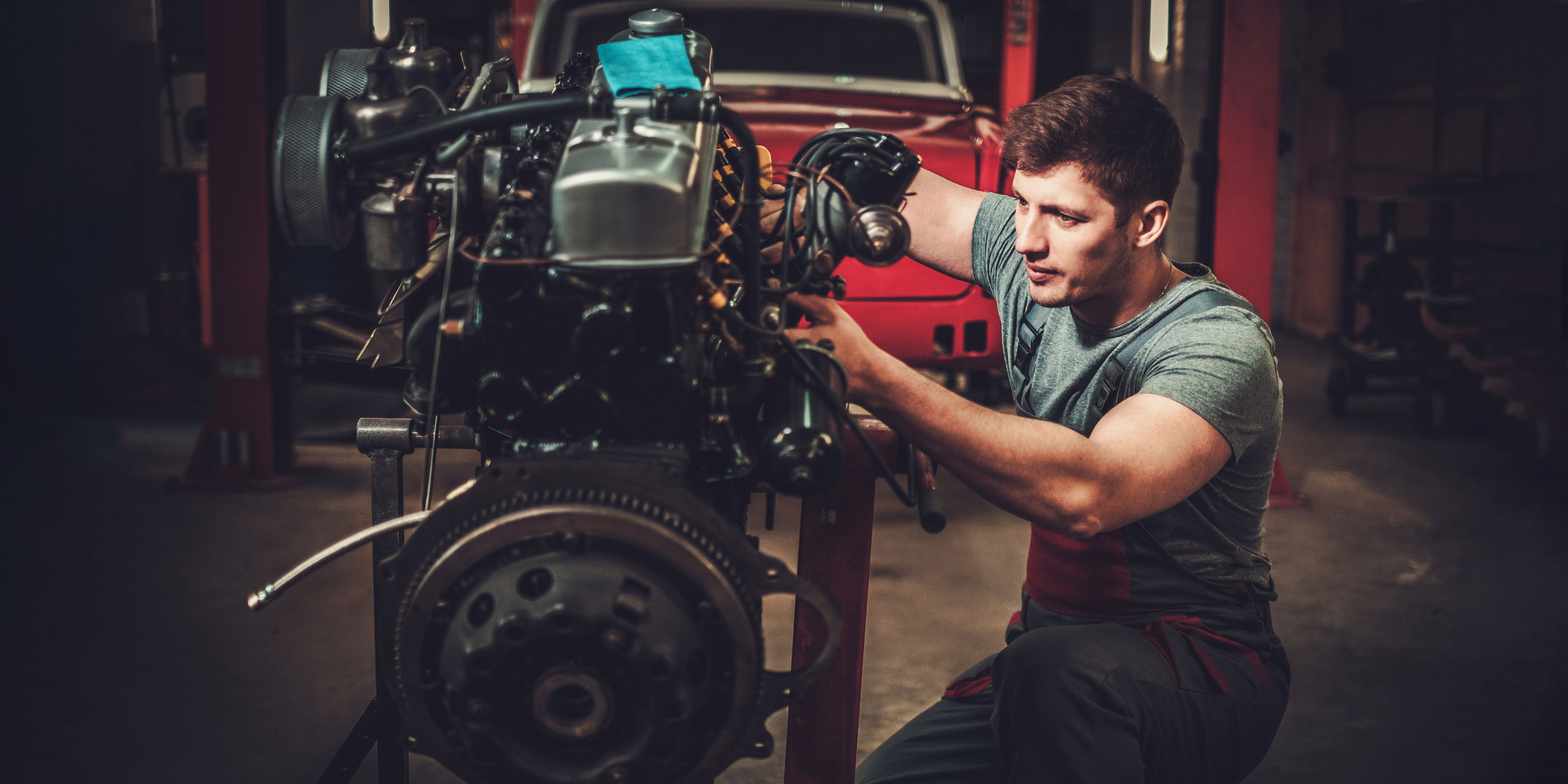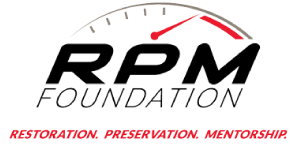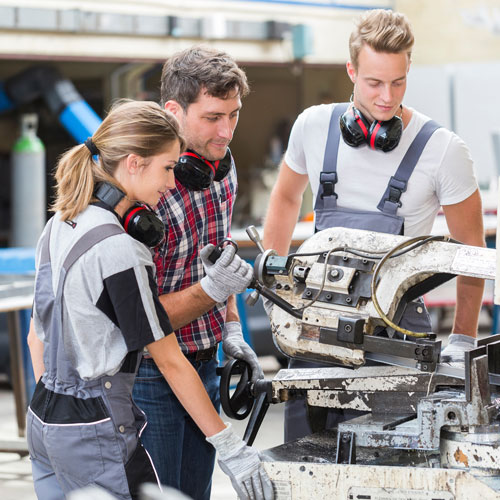
Classic car apprenticeships: An interview with the RPM Foundation
Research Director, Indiana University Kelley School of Business
Executive Director, RPM Foundation
Meet Mr. Nick Ellis, the executive director for the Restoration, Preservation and Mentorship Foundation.
This foundation provides financial awards to support training for classic vehicle restoration careers. It sponsors events to raise the profile of the classic car industry. It also builds a network of businesses to help establish linkages between companies that need specialized craftspeople and those – usually recent high school graduates – wanting to launch a career in classic automobile restoration. RPM is an apprenticeship advocate with a goal of closing the talent and experience gap in restoration.

The RPM Foundation supports restoration and preservation training programs for the next generation of automotive, motorcycle and marine craftsmen.
As the educational arm of America’s Automotive Trust, the services, resources and grants provided by the RPM Foundation safeguard the future of the collector vehicle industry by sustaining hands-on training for those who are passionate about vehicle restoration and preservation.
 NICK ELLIS
NICK ELLISNick spoke to me about RPM and their role in the classic car restoration ecosystem. What follows is a summary of that interview, touching on significant points and key takeaways based on what Nick communicated.
Three primary topic areas unfolded during the course of our interview:
- What does it take to set up a certified, nationally recognized apprenticeship?
- What are the challenges?
- How do you replicate apprenticeship across industries and occupations?
Regarding the latter point, there are not many examples in the U.S. In some cases, the replication issue is industry scale – vehicle restoration is small, while the contemporary auto sector is huge. Given that the U.S. doesn’t have a long apprenticeship track record, industry, government and associations are still, but rapidly, finding their way.
Forging apprenticeships
The U.S. Department of Labor (DOL) has an apprenticeship-focused website (apprenticeship.gov) to find most of what one needs to develop a Registered Apprenticeship Program (RAP). A registered apprenticeship is an industry-driven career pathway where employers can develop and prepare their future workforce. Individuals benefit, as a recent high school graduate can obtain paid work experience and receive progressive wage increases, classroom instruction and a nationally recognized credential. Registered apprenticeships are industry-vetted, approved and validated.
Nick is quite complimentary about the programs that the DOL has designed and funded. He even gives them good marks for accessibility to labor department decision-makers. The number of DOL occupations that align with an apprenticeship is a bit overwhelming. There are more than 1,000 occupations listed on www.apprenticeship.gov. There are also a similar number of apprenticeship titles based on registered programs. These two data sets do not appear to be matched up at the national level, at least not yet, so mapping an apprenticeship to a particular or a family of occupations is difficult.
Challenges
Despite the multitudes of occupational and apprenticeship options, what is relevant for Nick and the RPM Foundation is there is no auto restorer-specific occupation definition. Ideally, the occupation of “auto restorer” would encompass four occupational specializations: auto mechanic, body and paint, structural metal restoration and interior and upholstery.
It's unlikely that one individual would go through all four occupation trainings. More likely, someone would focus on one occupational definition, like automotive mechanical restorer. This occupation's training would include concepts from the other three areas – for example, body disassembly/reassembly – to ensure the apprentice is able to perform their work in coordination with their peers and other specializations in the shop. This is not unlike an apprenticeship to be an electrician: In order to wire a house, one would not need to go through the plumbing, carpentry and masonry occupational training tracks as well. That said, an electrician would need to be familiar with other related construction trades. The trades in wires, pipes and support structures need to cooperate with each other.

The restorer occupation is multifaceted and the shops doing the restoration work are spread throughout the country. Hiring for a restorer is not like hiring dozens of team assemblers at an auto plant at scale and replacing them gradually as they retire. There are a handful of restorers at each shop. There are no scale economies. In addition, in restoration, there are no regional specializations or benefits of agglomeration. This is very niche. A vehicle needing restoration may be transported from anywhere in the world to a particular shop.
The RPM Foundation, then, serves in the role of the connective tissue in the talent network. To get the right person to the right location/shop at the right time requires several channels of contact. For example, those contact points may be a local high school welding instructor, a junior college vocational center or a classic car show.
Not only are there challenges associated with registering an official, nationally recognized apprenticeship, but there are other concerns and hurdles in generating interest in them.
Arguably, the crafts, or hands-on trades, have fallen out of favor, especially among the Gen Z constituency. Nick made the point that working with one’s hands and brain aren’t promoted as options in the career landscape, especially in contrast to Europe. Guidance counselors, to the extent that they guide a student toward exploring several professional options, don’t tend to have the crafts or trades on their menu of options here in the U.S. In Europe, in contrast, a student can consider career options that are not college credential-based early in his or her educational development.
If shop classes were vigorously reinstated, there may be greater interest and greater competencies in the trades. Students might find the computer and coding skills they developed in junior high have great relevance in physical design and build. Shop class isn’t just hammers and wrenches. There are considerable coding and software applications used in restoration work, as well as other occupations in manufacturing. And, in the case of RPM and restoring vehicles, there is a significant amount of historical research work that serves as both background and guidance in the restoration process.
Growing apprenticeships
 When the word “manufacturing” is used nowadays, it is, more often than not, preceded by the term “advanced.” The two joined together convey a message. But how do we get the skills and know-how for the labor force to be ready for the manufacturing of tomorrow?
When the word “manufacturing” is used nowadays, it is, more often than not, preceded by the term “advanced.” The two joined together convey a message. But how do we get the skills and know-how for the labor force to be ready for the manufacturing of tomorrow?
Currently, there are claims of significant talent shortages which are slowing manufacturers’ efforts to expand, innovate and excel, even as there appears to be a movement to reshore many production activities. How will manufacturing today progress to the future, given the multiple challenges of an aging and retiring workforce, attracting talent to emerging jobs, ensuring today’s talent keeps pace with technological advances and designing and funding agile and effective workforce training methods to develop talent? Given that the profitability and sustainability of companies – from auto restoration shops to large robotic system integrators – is contingent upon developing and keeping talent, it is in industry’s collective interests to embrace apprenticeships and other models of on-the-job skills building, even if there are short-run pains and costs.
Here is where the operationalization and replication of apprenticeships for smaller enterprises, such as classic car restoration, may diverge from larger enterprises, such as robotics manufacturing. The latter might be called apprenticeships “at scale.” That scale divergence was not discussed in our interview, which focused on RPM and how apprenticeships can address training needs in general. It may not be a stretch, however, to speculate that the face-to-face and shoulder-to-shoulder nature of mentoring may lead one to question easy scalability in apprenticeships.
Takeaways
Apprenticeships are more likely to flourish if there are foundations and intermediaries to assist in matching early career prospects, i.e., recent high school graduates, with suitable companies and programs, guaranteeing credentials and providing some funding to backstop the expensive process of on-the-job training.
Bring back robust shop and vocational courses. Crafts and trades apprenticeships are likely to increase uptake if there are foundational courses and skills taught as students enter their teens.
The Department of Labor has both expanding and promoting apprenticeships on its policy agenda, creating resources for those entering their careers and for firms wishing to connect with the raw talent.
Nudge state and regional governments to build and support intermediaries, such as the RPM Foundation, for bundles of similarly skilled occupations or clusters of industries.
While firms in the same industry and same region may be competitors in the marketplace, they can band together to sustain and manage their shared, common resource, the regional labor force.
When RPM started, they learned many lessons from the Heritage Skills Academy in the United Kingdom. And like the human-to-human contact of mentoring apprentices, licensing, learning and coordinating with Heritage Skills is a long-term process. Closer to home, however, the DOL has continued to fund and facilitate the Apprenticeship Building America Grant Program. For policymakers or business executives wanting to know how to ramp up apprenticeship programs to industrial scale, there may be a word of caution: Mentoring is critical, but may be difficult to scale up. The RPM Foundation may know something about that. After all, mentorship is in their name.
For more information about the RPM Foundation, visit their website.
For more information on the U.S. Department of Labor Registered Apprenticeship Program or to search for specific apprenticeships, visit the ApprenticeshipUSA website.



